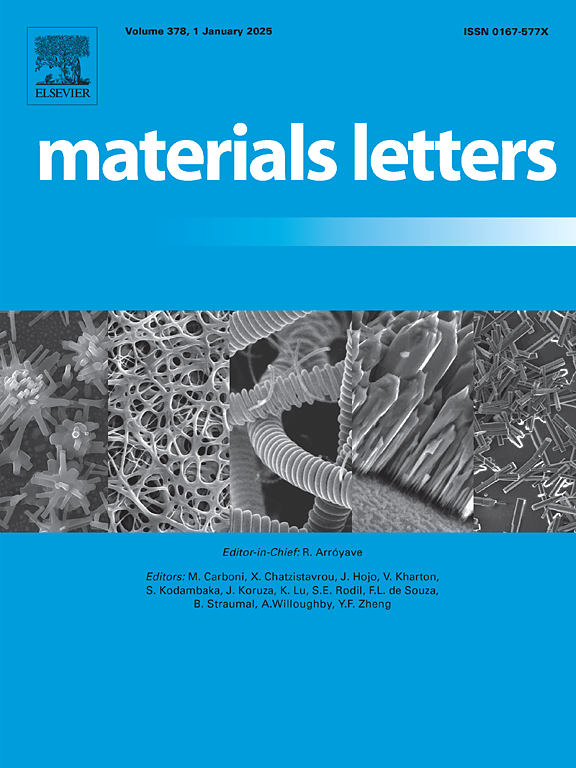一步激光烧蚀法检测自偏置TiO2/Si异质结构紫外-近红外
IF 2.7
4区 材料科学
Q3 MATERIALS SCIENCE, MULTIDISCIPLINARY
引用次数: 0
摘要
本文阐述了一种通过水中一步激光烧蚀制备自驱动、高响应的宽带TiO2/Si异质结光电探测器的直接方法。合成的TiO2纳米粒子沿3.6 eV的光学带隙平均直径为22.43 nm。制备的TiO2/Si异质结构在405nm光照下表现出明显的自偏置模式;当Iph/ID比达到105时,发现这一点,而在黑暗环境下,发现整流比为288。制备的异质结构沿UV-NIR区呈现出响应率曲线(Rλ),在UV和NIR区峰值分别为0.2和0.38 a /W,表明所利用的TiO2和Si层具有积极作用;这些值是在零偏置电压下获得的,证明了所提出的几何形状的自驱动模式。在近红外区,比探测率(D*)和外量子效率(EQE)分别达到41×1011 Jones和65%。本文章由计算机程序翻译,如有差异,请以英文原文为准。
Self-biased TiO2/Si heterostructure for UV-NIR detection via one-step laser ablation process
This article elucidates a straight forward approach for the fabrication of self-driven, highly responsive broad-band TiO2/Si heterojunction photodetector via one step laser ablation in water. In detail, the synthesized TiO2 nanoparticles revealed the occurrence of average diameter of 22.43 nm along optical bandgap of 3.6 eV. The fabricated TiO2/Si heterostructure exhibited a distinguished self-bias mode under illumination of 405 nm; this was perceived along ratio reaching 105, while the rectification ratio was found to be 288 under dark setting. Continuously, the fabricated heterostructure revealed a responsivity () profile along UV-NIR region with peak values of 0.2 and 0.38 A/W at UV and NIR regions, respectively, indicating the active role of the utilized TiO2 and Si layers; these values were obtained at zero bias volage evidencing the self-driven mode of the proposed geometry. The specific detectivity (D*) and external quantum efficiency (EQE) of Jones and 65 % were attained at the NIR region, respectively.
求助全文
通过发布文献求助,成功后即可免费获取论文全文。
去求助
来源期刊

Materials Letters
工程技术-材料科学:综合
CiteScore
5.60
自引率
3.30%
发文量
1948
审稿时长
50 days
期刊介绍:
Materials Letters has an open access mirror journal Materials Letters: X, sharing the same aims and scope, editorial team, submission system and rigorous peer review.
Materials Letters is dedicated to publishing novel, cutting edge reports of broad interest to the materials community. The journal provides a forum for materials scientists and engineers, physicists, and chemists to rapidly communicate on the most important topics in the field of materials.
Contributions include, but are not limited to, a variety of topics such as:
• Materials - Metals and alloys, amorphous solids, ceramics, composites, polymers, semiconductors
• Applications - Structural, opto-electronic, magnetic, medical, MEMS, sensors, smart
• Characterization - Analytical, microscopy, scanning probes, nanoscopic, optical, electrical, magnetic, acoustic, spectroscopic, diffraction
• Novel Materials - Micro and nanostructures (nanowires, nanotubes, nanoparticles), nanocomposites, thin films, superlattices, quantum dots.
• Processing - Crystal growth, thin film processing, sol-gel processing, mechanical processing, assembly, nanocrystalline processing.
• Properties - Mechanical, magnetic, optical, electrical, ferroelectric, thermal, interfacial, transport, thermodynamic
• Synthesis - Quenching, solid state, solidification, solution synthesis, vapor deposition, high pressure, explosive
 求助内容:
求助内容: 应助结果提醒方式:
应助结果提醒方式:


